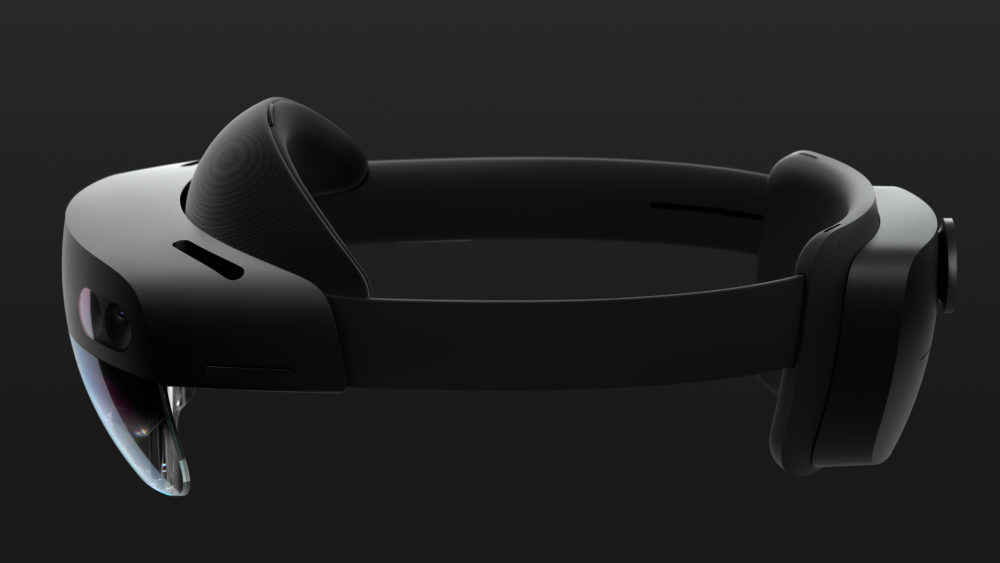
Augmented/mixed/extended reality: call it what you will, the vision of intelligently supplemented reality™ sometimes seems like an eternal promise.
Glitch-raddled digitally enhanced reality imparted via a chunky headset has, thus far, been a niche sport; albeit one widely recognised to have huge potential.
At $3,500 per headset, with app bundles starting at $125/month, Microsoft’s HoloLens 2 – released this weekend – is asking for a notable outlay to businesses to get involved.
Buyers will, however, get a new and much improved carbon fibre headset with eye-tracking sensors – that make interacting with holograms easier – iris recognition to enable secure headset sharing, and a powerful new time-of-flight depth sensor.
This helps track users’ hands controller-free, allowing them to engage with various interfaces in thin-air. More prosaically the HoloLens 2 has also been designed to work with glasses, weigh less and sit more comfortably on the head.
 An “exploded view” of HoloLens 2. Credit: Microsoft
An “exploded view” of HoloLens 2. Credit: Microsoft
The headset, which Microsoft hopes to see widely adopted by frontline workers across industry, the medical and educational sectors, is powered by a Quallcomm Snapdragon 850, comes with 2K 3.2 light engines in each eye, is Bluetooth 5.0-equipped and comes with an 8MP stills camera and 1080p video.
Equally important, enterprises and their developers will also now have access to two new Azure mixed reality services. These have been “designed to help every developer and every business build cross-platform, contextual and enterprise-grade mixed reality applications.”
Read this: Tech Consortium Agrees to Industry Standard for VR Headset Cable
Azure Spatial Anchors, currently released as a free preview (pricing to follow later this year) lets developers create mixed reality apps.
Azure Remote Rendering, currently in private preview, lets users render high-quality 3D content in the cloud and stream it to edge devices like the HoloLens 2, in real time.
Are these enough to take the HoloLens 2 mainstream?

HoloLens 2 Launch
J.P. Gownder, Vice President and Principal Analyst at research house Forrester thinks they just may.
He said in an emailed statement: “The device itself solves many problems associated with the first model — from a vastly expanded field of view to better hand gestures.”
“But it’s the integration with Azure and Dynamics that will empower developers to create powerful mixed reality experiences more quickly and cheaply. For the old HoloLens, editing the number of polygons forming a hologram into a manageable number was challenging and expensive.”
“With cloud tools, developers can render an object in, say, 50,000 polygons on the device but also can render it in the Azure cloud with one million polygons visible to the user. This turbo-charges the opportunity for creating holograms that workers can interact with during their daily jobs, helping them solve previously intractable problems. The new HoloLens is a huge step in overcoming the physical-digital divide for workers, who can use holography to augment their perceptions in a myriad ways.”
 Nick McQuire, Vice President, Enterprise Research at analyst firm CCS Insight sounded slightly more cautious: “This is a critical moment in Microsoft’s ambitious plans for HoloLens and for mixed reality in general. Redmond is assembling an attractive set of applications, developer tools and now an improved headset which may just help mixed reality move beyond its niche, science experiment status inside companies.”
Nick McQuire, Vice President, Enterprise Research at analyst firm CCS Insight sounded slightly more cautious: “This is a critical moment in Microsoft’s ambitious plans for HoloLens and for mixed reality in general. Redmond is assembling an attractive set of applications, developer tools and now an improved headset which may just help mixed reality move beyond its niche, science experiment status inside companies.”
“The jury is still firmly out on whether Microsoft can convince companies to go all in on HoloLens but if there is one company that can do it, it is probably Microsoft.”
Read this: AR Goggles for Enterprise Use: Business Interest and Product Range Heat Up
He added: “Whilst improving the security and design will be major pluses, Microsoft will need to ensure there are durable and rugged models from partners for industrial applications and that it works well on a range of Wi-Fi signals for it to have mass appeal and overcome previous problems. In time, we would expect a 5G Hololens model will arrive as well. The key to unlocking the potential of HoloLens is the developer community. Microsoft already has an enviably position in this regard and the financial resources to really incentivise developers to invest in the platform.”
“The announcements show us that we are now entering the next phase of computing experiences with immerse and mixed reality at the core and this phase will likely be incubated in the enterprise first. It is a shift from the iPhone-driven mobile app experience we have seen dominate over the past 10yrs which was born from in the consumer experience first.”
Microsoft has touted a wide range of industrial, educational and medical case studies for the headset.






